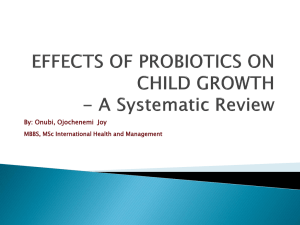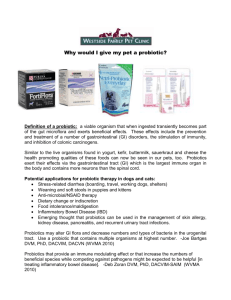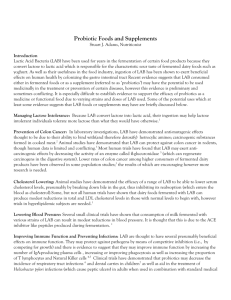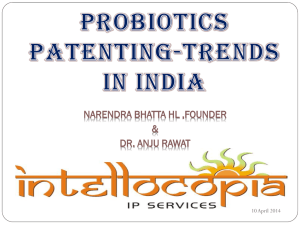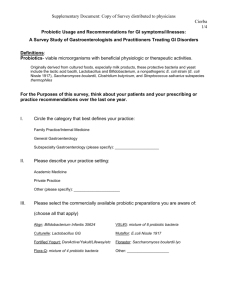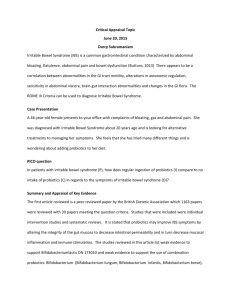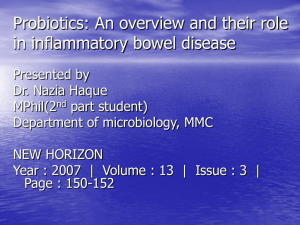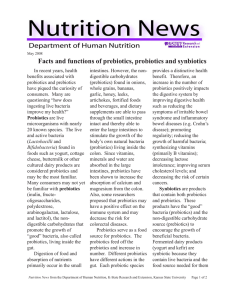The nature pf prebiotics and the impact of prebiotics/probiotics on
advertisement
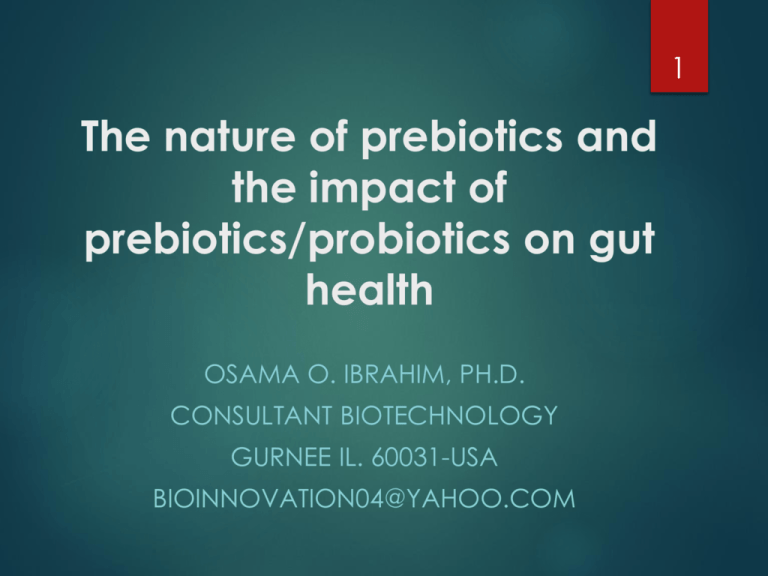
1 The nature of prebiotics and the impact of prebiotics/probiotics on gut health OSAMA O. IBRAHIM, PH.D. CONSULTANT BIOTECHNOLOGY GURNEE IL. 60031-USA BIOINNOVATION04@YAHOO.COM Agenda Probiotics and its benefits. Probiotics microorganisms Prebiotics and its benefits. Chemical structure of some prebiotics. Inulin, oligofructos, FOS and GOS. The definition of synbiotics . Microencapsulation. Probiotic market. 2 Probiotics 3 Probiotics are viable bacteria which colonize in the large intestine and provide health benefits to the host. Probiotics also colonize in the upper part of the intestine and prevent the adhering of pathogens to the intestinal tract (competitive exclusion). Probiotics also help in food digestion and improve immune response. Probiotoc Microorganisms 4 There are numerous probiotic microorganisms: 1. Fermented foods: Lactobacillus rhamnosus, Lactobacillus reuteri, Lactobacillus casei, Lactobacillus acidophilus and bifidobacteria. 2. Investigated: Escherichia coli Nissle 1917, Enterococcus faecium SF68, and the probiotic yeast Saccharomyces boulardii. Benefits 5 Maintaining healthy digestion and friendly bacteria level. Assisting with digestive disturbance (e.g. bloating, flatulence, diarrhea, constipation, poor digestion). Maintaining a healthy-immune system and energy level. Supporting the gut during and after antibiotics treatment. Maintaining healthy liver function. Supporting clear healthy skin. Prebiotics 6 Prebiotics is a general term to chemicals that induce the growth and the activity of commensal microorganisms that contribute to the well-being of the host. Its function is in the gastrointestinal tract, where prebiotics can support probiotics growth and alter the distribution of organisms in the gut microbiome. Prebiotics can also function in other areas of the body as well. Type of prebiotics 7 Prebiotics are classified as soluble fiber. It is the type of fibers that our gut flora can actually consume and ferment. These type of soluble fibers are: 1. Inulin and oligofructose. 2. Fructo-oligosaccharides (FOS). 3. Galacto-oligosaccharides (GOS). 4. Other oligosaccharides. Polysaccharides Oligosaccharides Polysaccarides (Inulins and Oligofructose) Inulins belong to a class of dietary fibers known as fructans. Inulins are a group of soluble fibers naturally produced by many types of plants, industrially extracted from chicory. Oligofructose belongs to a subgroup of inulin. It's found in various vegetables and plants, including onions, bananas, garlic, chicory and wheat 8 Innulin Fructose polymer B2-1 DP 60 Oligo fructose Fructose polymer B2-1 DP 10 Oligosaccharides 9 Oligosaccharides are important group of polymeric carbohydrates that are found in all living organisms. Oligosaccharides composed of 2 to10 monosaccharide residues. These mono-saccharide's linked together by glycoside bonds. The discovery of enzymes helps in the production of oligo-saccharides with high yield and coast effective. Oligosaccharides Substrates Enzymatic process 10 Oligosaccharides Substrate Fructo-oligosaccharide Sucrose Galacto-oligosaccharide Lactose. Malto-oligosaccharide Starch. Iso-malto-oligosaccharide Xylo-oligosaccharide Xylan. Soy-oligosaccharide Soy. Starch. - Oligosaccharides properties 11 Low sweetness intensity (1/3 of sucrose). Highly soluble than sucrose. Zero calorie (calorie free). Heat stable (doesn't degrade by heating process) Resistance to hydrolysis by digestive enzymes. Hydrolyze in high acid environment. Non-cariogenic (inhibit the growth of Streptococcus mutans). Oligosaccharides general benefits 12 • Prebiotic (enhance befidus bacteria in colon). • Increase digestion of lactose metabolism. • Increase mineral absorption. • Increase HDL/LDL ratio. • Decrease serum lipids and blood cholesterol. • Decrease blood pressure. • Decrease glycemic response. • Decrease fecal PH, toxic, and carcinogenic metabolites. Oligosaccharides Legal status Oligosaccharides cannot be labeled as sugars or carbohydrates. They are food ingredients not food additives. Can be applied without restrictions. 13 Fructo-oligosaccharides (FOS) GF Sucrose O-α-D-glucopyranosyl-(1-2)β-D-fructofuranoside Substrate products 14 Fructo-oligosaccharide (FOS) Naturally occurring (fruits and vegetable). Built from sucrose (D-glucose and D-fructose). 15 G- (F)n-F Enzymatic reaction: - GF +GF GF2 (1-Kestose) - GF +GF2 GF3 (Nestose) - GF + GF3 GF4 (fructosyl-nestose) By-product: - Free glucose (process enzyme inhibitor) Fracto-oligosaccharides products of enzymes Enzymes: - Fructosyltransferase (EC 2.4.1.9). - B-fructofuranosidase (EC.3.2.1.26). Microbial source: - Aureobacidium pullulans. - Aspergillus niger. - Fusarium Sp. - Arthrobacter sp. - Lactobacillus vulgalicus 16 Galacto-Oligosaccharides 17 (Substrate) Galcto-oligosaccharides (GalOS) 18 Naturally occurring in milk products. It is one of the major oligosaccharide in Japan. It is built from lactose(D-glucose and Dgalactose). G-(Gal)n-Gal % of mixture G-Gal G-(Gal)2 G-(Gal)3 G-(Gal)4 di-saccharide 33 % tri-saccharide 39 % tetra-saccharide 18 % penta-saccharide 7 % Galacto-oligosaccharides (GalOS) Enzyme Lactose + Lactose GalOS + G G-Gal, G-(Ga)2, G-(Gal)3, G(Gal)4 Process by-product: - Glucose (enzyme inhibitor in the process). - Galactose (galactocymia in the blood) 19 GalOS Production Enzyme Enzyme name: - B-galactosidase (EC 3.2.1.22). (Also known by the name lactase) - B-galactosyl transferase (EC 2.4.1.134) Microbial source: - Aspergillus niger. - Aspergillus oryzae. Kluyveromycin lactis. Kluyveromycin Fragili. Bacillus circulans. Streptococcus thermophilus. 20 Synbiotics 21 the United Nations Food & Agriculture Organization (FAO) recommends that the term "synbiotic" be used only if the net health benefit is synergistic Synbiotic concept was first introduced as “mixtures of probiotics and prebiotics that are beneficially to the host. Protecting Probiotic Bacteria 22 Probiotic bacteria play an important role in promoting and maintaining human health. In order, to produce health benefits probiotic strains should be in a viable form during: (1) its shelf life until consumption and (2) maintain its high viability throughout the gastrointestinal tract. Experimental data indicated free probiotic cells have a poor survival rate. Maintaining probiotics in a viable form (living cells) is the must approach. Develop a physical barrier for probiotics to be protected from adverse environmental conditions. Protecting Probiotic Bacteria 23 Microencapsulation 24 The microencapsulation techniques enhanced viability of Probiotics in food products as well as in the gastrointestinal tract. microencapsulation is a process to entrap active agents (probiotic/prebiotic) within a carrier material and convert them into a powder form for convenient use. microencapsulation prevent these microorganisms from multiplying in food that would otherwise change their sensory characteristics In addition, microencapsulation can promote controlled release and optimize delivery to the site of action. Micoencapsulation A technology to Protect Probiotic Bacteria 25 Materials used for Microencapsulation Various types of encapsulating materials are used for the process. Namely, alginate, chitosan, carrageenan, gums (locust bean, gellan gum, xanthan gum, etc.), gelatin, whey protein, and starch. The selection of any material depends on (1) its capsule forming capability, (2) its strength, (3) its enhancing viability of probiotics, (4) its cheapness, (5) its availability, and (6) biocompatibility. 26 Microencapsulation Techniques 27 The techniques are divided into two parts: (1) Encapsulation process. (2) Drying process (freeze drying , spray drying , fluidized bed drying ). Encapsulation Process Extrusion Technique Emulsion Technique Probiotics market 28 Food & beverages dominated the application market and accounted for over 80% of the total probiotics market. Asia Pacific emerged as the most dominant regional market, accounting for over 50% of the total market share. This owing to the fact that the concept started in Japan. The global market for probiotics is expected to reach $ 52.34 billion by 2020. Asia Pacific is also expected to be the fastest growing market. Probiotics market 29 In the United States, probiotics are available as dietary supplements (capsules, tablets, and powders) and in dairy foods (such as yogurts with live active cultures). Probiotics for human consumption accounted for over 90% of the total market, probiotics have made significant growth in the animal feed industry and are expected to grow. Conclusion 30 Growing consumer awareness regarding gut health has pushed the demand for supplements and dietary products. This awareness has tremendous reflect on probiotics consumption. Probiotics expected to play a critical role in market development over the next years. Labeling and regulations, especially in the U.S. and European Union, are also expected to have significant impact on market growth. 31 Thank You for your attention

